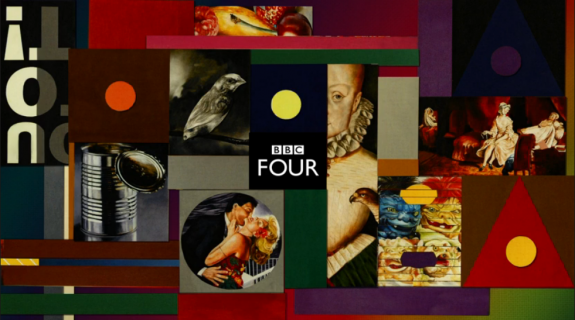In fall of 2014, the UK’s arts-and-culture-focused channel BBC Four presented a season of programming focused on the abstract movement in visual art. As part of the packaging for the programming, it commissioned four idents from actual, renowned abstract visual artists, a ploy that worked so well, BBC Four has done it again this fall – this time based on a slate of programming in the theme of pop art.
The selection of this year’s trio of BBC-commissioned pop artists was inspired by Ken Russell’s 1962 documentary Pop Goes the Easel, a “classic piece of art television in which Russell captures in black-and-white film the energy and dynamism of a group of young artists who are in this newly designed pop movement,” said Lindsey Hanlon, the projects lead at BBC who headed up the artist idents project.
Those visionaries included multimedia and collage artist Peter Phillips (whose ident appears above), painter (and Sgt. Pepper’s Lonely Hearts Club Band album sleeve designer) Peter Blake, and the painter, sculptor, photographer and filmmaker Derek Boshier. The fourth artist that appeared in the film, Pauline Boty, has since passed away.
“We thought wouldn’t it be really interesting to revisit that program but in a contemporary way, by inviting the artists to create channel idents,” said Hanlon, “reuniting them on the BBC more than 50 years since [Pop Goes the Easel] transmitted on BBC television.”
Hanlon said that working with the three artists was “a privilege” and that all “were all very positive about the brief.” Even though there were certain, necessary constraints imposed “by the nature of the device… that posed a very inspiring challenge for them. They also really respect the BBC, so having their work showcased like that on the channel was an interesting opportunity as well.”
One element of the brief given to each artist was the incorporation of the BBC Four logo.
Because most promos, even those designed by world-renowned artists, have to appear in versions of different lengths at different times, Hanlon said that BBC “asked that the logo resolve no later than 16 seconds into the ident and appear again at the end.”
Even within that restriction, however, the artists’ respective interpretations are unique and innovative. Blake’s usage is fairly straightforward as the logo appears quite early on in the ident and proceeds to rise with the camera through the clouds of thought bubbles. Phillips turned it into one of the shifting frames of ephemera that constitute his spot, and Boshier plays with it across mobile device screens that appear throughout his ident, even sneaking in a hand-drawn version at one point.

Overall, said Hanlon, the artists “had huge creative freedom to deliver something that they felt was very much representative of their own artwork. We wanted them to have autonomy as much as possible given that we were giving them a brief. We wanted it to feel very much like a Boshier artwork or a Phillips artwork, etc.”
For fans of the artists, part of the fun of the idents is seeing their distinctive approaches to still imagery transition to animated form. Peter Blake’s ident (seen below), aimed “to revisit an earlier drawing” in his portfolio, said Hanlon, “which is in black and white, [and] which plays on this notion of the ‘60s and black-and-white television culture.”
As the spot progresses, it journeys through “the themes and connotations of BBC Four,” to the present day, “a channel that likes to inquire, has a playfulness, a curiosity… The female head with thought bubbles really strikes a chord with that identity. For [Blake], those two things correlated very clearly – the black-and-white and hearkening back to TV of old, and suggesting TV now and the motivations now behind BBC4 and its identity.”
Meanwhile, Boshier’s tablet-driven spot (seen below) works on “this idea of contemporary manifestation of pop culture,” said Hanlon, “of multiplicity of imagery… The way in which images are used. [The artists] were working at the time [of Russell’s film] with collage and with found source material and of course now source material is so easily accessible, so there’s lots of interesting layers that touch on the contemporary as well.”
And finally, Phillips’ ident (seen at top) draws from his works that involve “multiple compositions and surfaces and sources,” Hanlon said. “Peter was keen to survey a body of work across the ‘60s and ‘70s and almost deconstruct it in a sense using animation. In his mind it was kind of animating the painting and really referencing its call-out of construction, so it was almost deconstructive of the process of animation… The key thing there was keeping the very clean and precise formal qualities of his painting, which was an important part of his aesthetic.”
Ultimately, said Hanlon, who has a background working in art galleries herself, “it was a pleasure to interact with” the artists, “and to be able to talk to these people who are part of history. It was actually very refreshing; they were artists who were in a sense quite brave in embarking on something new.”
Tags:













































__twocolumncontent.jpg)











